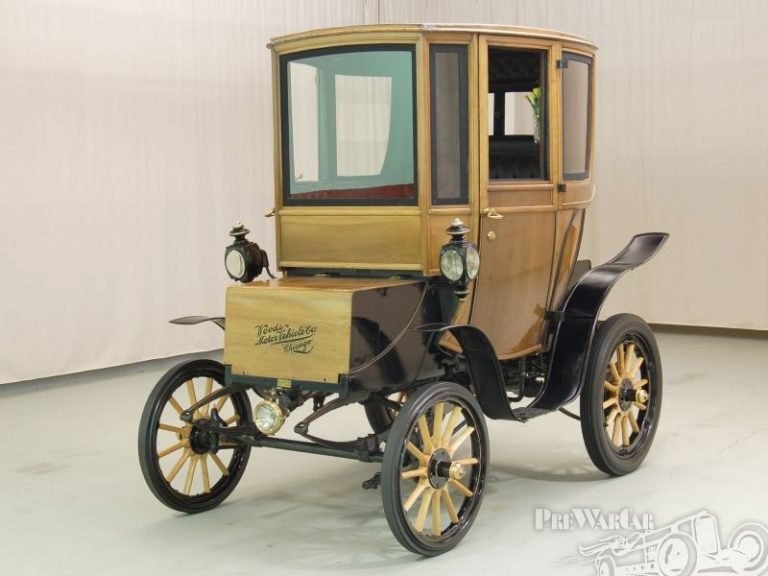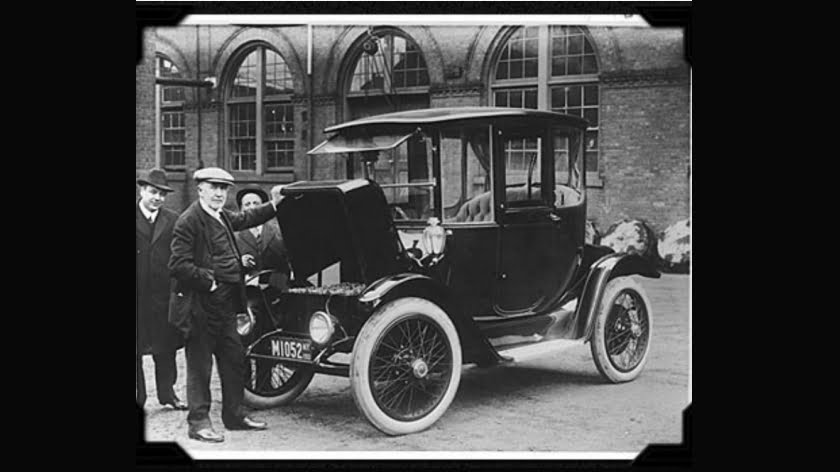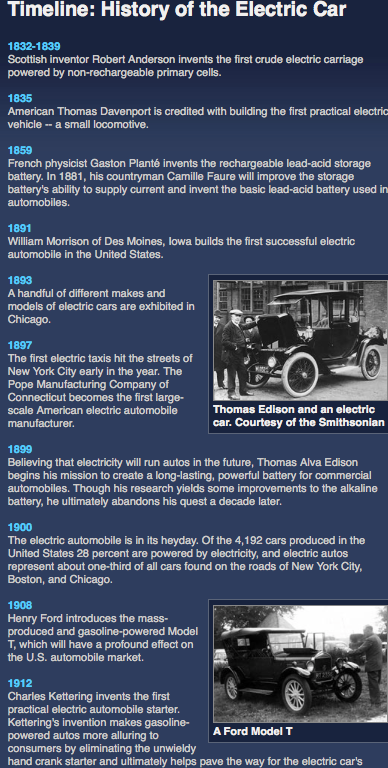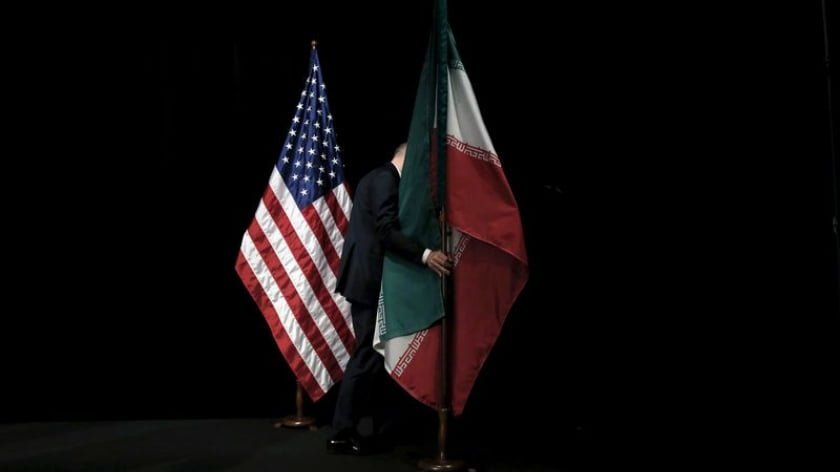“The American Love Affair with the Automobile”: The Unspoken History of the Electric Car
A study of gasoline-powered automobiles reveals one of the greatest corporate frauds and resulting environmental disasters to ever have been inflicted on human society.
There are three distinct but interwoven themes in this story: the promotion of gasoline-powered transportation by
(a) the killing of mass public transit,
(b) the genocide of electric vehicles, and
(c) the creation of suburbs in American cities to make auto ownership a necessity of life.
The American love affair with the automobile was a result of all three, beginning with a massive conspiracy to kill electric vehicles, which helped to kill mass transit and force Americans into private car ownership.

This story begins, as do most others, in the early 1900s, when the US was busy industrialising, when mass public transportation consisting of trains and trams was filling much of the nation’s needs. Autos were of course rapidly evolving at the same time, but gasoline-powered transportation, whether by private auto or mass transit, was on its way out. Almost all of the nation’s local and inter-city train transport was electric, and electric automobiles were rapidly gaining ground over their gas-powered rivals. By 1900, nearly 40% of all US cars were electric, and so popular that New York City had a fleet of electric taxis.
Early electric cars outperformed their gas competitors and people liked them because they didn’t have the smell, noise, or vibration of gasoline cars, were easier to operate, and didn’t require cranking or gear changing. The NYT noted that women especially preferred them for the absence of smoke and smelly fumes, especially when refueling. (1) (2)
It appeared a certainty that electric vehicles were the wave of the future, but then within only about three years the transportation landscape irreversibly changed and electric vehicles, like the dinosaurs, suffered a fatal climate change and died. It is tragic that electric automobiles were killed off so early in their life.Had that transition been permitted to occur at its inception, we would have now had more than 100 years of intense battery research and development and incalculable benefits to the world’s environment. We can only guess at the possible results. As one example, a few years ago a Chinese high-school student designed an electric hovercraft as an auto substitute requiring no expensively-surfaced roads. This VW Aqua won an international award.
At that time, General Motors and the major oil companies were facing a multiple crisis. The auto market had already been saturated and sales growth so anemic that in 1921 alone GM lost more than $65 million and was well on its way to the cemetery, oil company revenues and profits sharing this dismal future. GM and its friends realised their only hope for salvation was to eliminate their one rival – mass public transport, and hatched a plan that would forever change the course of the US economy, its transportation culture and society. One hundred years ago General Motors, John Rockefeller, and a few close friends, using very large sums of money and every form of deception, coercion and intimidation short of murder, singlehandedly killed the US electric auto and train industry, buying up and destroying the rolling stock of almost 1,000 US railroads and tramways so it could sell them gasoline-engined vehicles instead, and virtually killing off mass public transit at the same time. (3)
According to the company’s own files, GM created a special secret division charged with the task of exterminating mass transit and replacing it with gasoline-powered propulsion, eliminating all traces of electric vehicles. At the time, GM was an enormously powerful firm, possessing great financial leverage with the banking systems and therefore over the railways which required bank financing and support. They threatened each railroad with a complete withdrawal of all lucrative freight business unless the rail company replaced its electric locomotives with GM’s gasoline-powered units. By every manner of extortion they attempted to force local transit systems to abandon electric trams and purchase GM’s gasoline-powered buses. According to US Justice Department records, GM executives visited the banks used by the various railways, offering them millions in additional deposits and other rewards in exchange for delivering financial threats to persuade their rail clients to abandon their electric systems and convert to gas-powered GM vehicles. GM’s threat to these banks was to withdraw all deposits if they refused to cooperate. (4)
In each case where this conspiracy was successful and local tramways converted to gasoline buses, GM not only bought and crushed the electric vehicles, but tore out all the tracks and redistributed the rights of way so that it would have been virtually impossible to ever rebuild these systems. In cases where their efforts failed, GM formed numerous holding companies with its invisible friends and attempted to purchase and convert the railways themselves. According to FBI files, in cases where rail systems could not be bought, GM bought the rail officials instead, bribing them with large sums of cash, gifts of new cars, and the use of threats and extortion in a surprisingly uninhibited manner. GM also sponsored and financed corrupt officials in countless municipal elections, who would then vote for the sale of their local electric rail system to GM. Most of this was done in the name of a holding company named National City Lines, which was jointly owned by GM, Standard Oil and Firestone Tire. In each case where these rail systems converted from electric to gas, they experienced a rapid and large decline in revenue, since passengers abandoned the slow and foul-smelling gasoline buses and purchased autos instead – which was part of the plan.

One stumbling block remained in that many local electric tramway systems were owned by the regional electric utility company, using their own surplus electricity for public transport systems, and here GM had no leverage. To eliminate this blockage, GM and its invisible people lobbied, bribed and extorted the nation’s elected politicians to pass new legislation that prohibited ‘regulated’ electrical utility companies from operating ‘unregulated’ businesses like the electric tramway and train systems. This cute legislative trick forced the utility companies to put all their electric train systems up for sale, all of which were immediately purchased by GM and its holding companies, and trashed. With these efforts and more, within three years, GM dismantled almost all of the 1,000 electric railroads and tramways in the US, having purchased and crushed for scrap metal their entire rolling stock, and replaced it with GM-made gasoline-powered units. (5)
Of course, there were court cases that attempted to deal with the multitude of illegalities, federal prosecutors charging that GM engaged in “a careful, deliberately planned campaign to swindle the American public out of its most important and valuable public utilities”. But American judges proved to be as easily bought as were the politicians and the matter eventually died in the courtrooms, with General Motors being fined $5,000 and GM’s Treasurer H. C. Grossman and a few others fined $1.00 each. Over the years, GM has defended its actions by blaming suburban sprawl and the resultant rise in sales of private automobiles, as well declining passenger loads in electric public transit, ignoring the fact that GM itself was responsible for those results. Wikipedia covers these facts in some detail, the only qualification being the claim that this is yet another irresponsible ‘conspiracy theory’. But, as usual, if we read Wikipedia and assume that everything claimed false is really true, we have quite an accurate picture.
But GM wasn’t finished yet. At the time, most people who wanted a car and could afford it, had already bought one, but an even greater problem was that even if you had a car there was no place to go. Roads were not plentiful and good roads almost non-existent; the most common motoring experience was being stuck in 60 cms. of mud with no help in sight. To deal with this lack of infrastructure, GM and its friends heavily lobbied, bullied and bribed Federal and State governments for the construction of roads and highways, and with great success. The US government embarked on a massive interstate road-building program that would cover the entire country. One of the greatest lies in American history books is the tale that this vast road-building program was initiated “for the war effort, to protect the country” in ways unspecified.
At the same time, the States were individually persuaded to abandon all investment (and maintenance !) in railways and other public transport, thereby sacrificing the good of the nation, instead making huge public expenditures on highways that were useful only to those who owned private automobiles, effectively stranding all other citizens at home with no way to go anywhere. This unconscionable sabotage of America’s transportation infrastructure by the auto and oil companies evidences the almost criminal ability of private corporations in a fascist regime to effect sweeping changes in public life and culture, without public accountability or debate, or even awareness.
GM didn’t stop with undermining the nation’s public transport and replacing it with a highway system for its private automobiles. There still remained the problem of encouraging, or forcing, people to buy cars. In any large European or Asian metropolis a private auto is unnecessary, since these cities exhibit exemplary city planning, designed for people rather than cars, with high residential density, excellent public transport, and no artificial segregation of basic functions like living, working and shopping. Ample evidence exists that the US took a very different route because the civic planning faculties of major US universities were infiltrated by auto makers and oil companies, then funded and instructed on the city planning philosophies that would make autos necessary. The result was that American (and Canadian) cities were planned, designed and constructed primarily, if not exclusively, to make private transportation mandatory. To its credit, the rest of the world was not seduced. European and Asian cities remain far more livable and enjoyable than any in the US. North Americans who don’t travel, cannot imagine the ease and comfort of life in these cities, their limited experience capable of conjuring up nothing more than images of life above a 7-11 in a strip mall.
Suburbs are an invention created and existing only in the US and Canada, designed entirely to keep workplaces, shopping and residences not only physically segregated but sufficiently scattered that even good public transport becomes ineffective or useless, thereby forcing hundreds of millions of people to spend hundreds of billions of dollars on private transportation solely for the benefit of the car makers and oil companies. This American-style city planning, the creation of suburbs, was one of the meanest anti-social schemes ever devised by American capitalism.
In so many North American cities life is impossible without a car. Economists at Harvard and Berkeley did a study named the Equality of Opportunity Project, which found a significant negative correlation between residential segregation and the ability of the poor to rise. Partly, this was separating rich and poor neighborhoods, but partly because in US-designed cities basically everything is very far apart from everything else, making an efficient public transport system almost impossible. The most notable result is that lower-income workers are stranded; there may be jobs available, but with no public transport and no car, they literally cannot get there. (6)
Sadly, this travesty of city planning is being exported internationally to unsuspecting students in other nations. China is being corrupted by these American city-planning “values” that benefit only companies like GM, evidenced by Shanghai’s Lujiazui or Nanjing’s lovely new University Town which are visually attractive but impossible to live in without a car, every place being much too far from every other place, and with public transport unable to cope. If China continues down this path, its cities will increasingly suffer the typical American social problems of poverty, areas of urban decay, intractable slums, and unmanageable traffic.
The following quote is so compellingly true it should be engraved on the mind of every citizen:
“The long term negative effects of this conspiracy of some of America’s most ruthless corporations are literally beyond calculation. The forced switch from environmentally-friendly public transit to the private car and diesel buses results in squandering irreplaceable petroleum resources and all the murder and mayhem which has gone to secure or steal oil around the world. The conspiracy to destroy electric autos and electric mass transport has resulted in vastly increased pollution and, ultimately, in climatic change. The engineered obsession with the private car has led to millions of excess deaths and injuries in automobile accidents, hundreds of billions of dollars in debt for Americans and a catastrophic change in the way American cities have developed, with the devastation of urban neighborhoods, the destruction of urban small business and countless other economic and sociological effects.” (Making the World Safe for Hypocrisy)
General Motors Refusal of Electric Autos
In 1990, the State of California passed new anti-pollution legislation mandating the production and use of zero-emission autos in the state, stipulating that if auto manufacturers planned to sell their products in California, 10% of those sales would have to consist of emission-free vehicles, which means electric automobiles. The state did not attempt to provide solutions to every driving problem nor to satisfy all possible needs of all motorists. The legislation was meant as a beginning of the process to eliminate the pollution from gasoline-powered automobiles, and so addressed attention to the large and easy sector of motoring society, the 70% of urban dwellers who face a two-way commute of less than 50 Kms per day. Recognising that electricity for recharging was available in virtually every imaginable place, California envisaged short-distance autos that could be recharged both at work and at home.
Based on this approach, the state rebuffed demands from the auto industry to first construct a vast network of charging stations, refusing to permit the automakers to shift their industry’s development costs onto the public sector. They simply said, “If you want to sell cars in our state, ten percent of your sales must be zero-emission vehicles. How you accomplish that is your problem”. There is no question California did it right, their approach both commendable and successful – for a while. All firms produced versions of electric or hybrid autos that met the requirements, with some like the Prius becoming permanent successes. GM’s contribution, the EV-1, was a simple auto powered by basic lead-acid batteries and with a range of only 100 Kms, but that was sufficient for the daily commute of most of the state’s urban motorists.
But GM and its oil-company friends violently objected to this compulsion for electric autos and, in surreptitious preparation to force a legislative repeal, GM refused to sell the EV-1 to customers, but offered it only on a lease basis so as to maintain ownership. GM, the oil companies and other auto-related firms then lobbied, pressured, bullied, bribed, and eventually sued the California government for repeal of the legislation, the US government led by President Bush eventually joining the legal action. Bush’s chief of staff Andrew Card had been head of the American Automobile Manufacturers Alliance, and White House staff like Dick Cheney, Condoleezza Rice, and other federal officials were former executives or directors of oil and auto companies. The US government had once again served the short-term interests of the corporate elite at the expense of long-term best interests of the nation.
GM and others created pressure groups to lobby against electric cars, pretending to be citizen action committees but who were financed by the auto industry. Intense and unremitting pressure was put on California to rescind its zero-emission laws until the state finally capitulated. The instant that happened, GM repossessed all its electric cars and crushed them for scrap. And so, for the second time, General Motors killed the electric car. GM later blamed this on insufficient demand but the electric cars were so loved that drivers handcuffed themselves to the cars to prevent GM from seizing them.
Following that event, the US auto industry, led by GM, initiated a noisy propaganda campaign to eliminate electric vehicles as much as possible from the public mind and government attention, using the promotion of hydrogen fuel cell development as a fraudulent distraction. Hydrogen is today far from a viable alternative for widespread public use, with many serious safety and distribution issues. Some manufacturers have produced concept cars they hope to put into production, but we are still decades from useful implementation.
There was another matter, relating to battery capacity and range. GM’s initial EV-1 used simple lead-acid batteries without problem, but foreign auto manufacturers (Toyota’s RAV-4) were already using nickel-metal-hydride batteries which delivered greater travel distances. At precisely that time, a firm named Ovonics had developed new NiMH technology that would have increased the range of electric vehicles to at least 400-500 Kms between charges, thereby making private electric transportation possible on a mass scale. GM immediately bought – at a very high price – the exclusive worldwide patent rights to this NiMH technology and locked it in a closet, refusing to license any firms to produce these batteries for auto use. GM later sold these patent rights to US-based Texaco-Chevron oil, who even today refuses access to this technology. NiMH has proven to be the best battery for plug-in electric cars, but manufacturers have been forced into lithium technology (which is about 6 times as expensive and with no recycle value) because of GM’s determination to prevent electric autos from ever becoming a reality. And so, for the third time, General Motors successfully killed the electric car. (7) As late as 2018, GM is at it again, killing the Volt, Cruze, and Impala, claiming public preference for SUVs. (8)
One of the main challenges is that auto makers derive far more profit from financing vehicle purchases and the sale of auto parts than from the sale of new vehicles. Prior to its bankruptcy, GM was making three times as much profit from both its finance arm and auto parts divisions, than from making and selling cars. Auto dealerships share this model where service and parts sales constitute less than 10% of revenue but 50% of profit. Since electric vehicles have perhaps only half the number of parts as their gasoline-powered relatives, and very few moving parts – almost none of which break or need regular replacement – they are more reliable and require much less maintenance or service than do gasoline-powered vehicles. These factors would eliminate a major portion of the revenue and the bulk of the profits of both manufacturers and their dealerships, forcing a massive reorganisation of the entire auto/transportation industry, to say nothing of exterminating most of the major oil companies.
Electric vehicles are clearly a threat to both auto makers and the oil industry who will stop at nothing to prevent their resurgence in spite of the vast environmental and social damage their products inflict. In addition to being massive pollutants, gasoline-powered cars are extremely wasteful and inefficient at energy conversion, producing mostly friction and wasted heat, with a full 65% of the fuel energy lost in engine and driveline inefficiencies and another 20% wasted in engine idling. Only about 15% of the energy from auto fuel is used to propel the car or operate accessories like air conditioning. For every $1.00 of expense, electric vehicles can travel twice as far as gasoline-powered units.
Electric cars are an existential threat to the international bankers who are the final beneficial owners of most of the major oil companies and who control in one way or another much of the world’s petroleum extraction and distribution, as well as heavy stakes in the auto manufacturers. Witnessing the trend to electric cars is like watching in slow motion the approach of one’s own funeral procession, one which appears unstoppable. The production and distribution of electricity cannot be controlled by these bankers because there are too many producers of electricity, mostly local or provincial governments who will not sell their infrastructure, and electricity is already widely distributed in almost every conceivable place. If these few extractive vampires cannot control the world’s fuel sources, if nations turn to electric autos with the NiMH battery or a new equivalent, and generate centrally their own electricity, our international bankers will suffer total losses in the trillions of dollars.
I noted above that hydrogen is still far from a viable alternative for auto fuels, with many serious safety and distribution issues, but this is not the real problem. Driving the frantic push to hydrogen fuel cell vehicles is the fact that the only useful source of hydrogen in the quantities necessary for auto fuel is petroleum or, more precisely, natural gas – methane. If these few people can force the conversion from gasoline to hydrogen, they will not only avoid the massive and costly restructuring looming for the auto industry with the change to electric cars, but will continue forever to control the entire production and distribution system for vehicle fuels. They are so desperate that Toyota has been bludgeoned into offering unlimited use of its thousands of fuel-cell patents without license fees until 2020, in the hope of kick-starting the process, in their words hoping to “spur development and introduction of innovative fuel cell technologies”. This small group of wealthy bankers is forcing and funding an enormous push for cooperation between all possible parties, in what they have called “unconventional collaboration”, in an attempt to instill so much speed into the process as to overwhelm and kill other forms of electric automobiles.
There is also the aspect of economic and political control, which is not a small thing. The small cabal of European bankers and industrialists who beneficially control most of the world’s international oil companies are on public record as stating that “If you control the oil, you control the world’s economies, and if you control the food, you control the world’s populations”. This is what is at stake; it is not merely their petroleum profits but their political and economic control of nations, that are severely threatened by the move away from petroleum fuels. Consider the fierce economic attack on Russia and Venezuela in late 2014 and 2015 by the dramatic depression in the price of oil, meant almost exclusively to collapse Russia’s petroleum-based economy. Such ‘sanctions’ would be equally successful if the world moves to methane-based hydrogen auto fuel, but would be futile with electric cars.
The matter is even more serious than mere control of the economies of other nations. Recall again that the US military is on record as determined to obtain “full-spectrum domination”, one reason the Americans have been making such a fuss about China’s island installations in the South China Sea. The US military has been counting on the power of its naval fleet to cut off China’s petroleum supply routes in the event of a war, and a Chinese military presence in that area might inhibit US domination of the sea lanes. A military without fuel is no military; all those ships and planes become immobile, useless hardware, as Japan discovered in 1940 when the US engineered a total embargo on oil to Japan, setting in motion the strike on Pearl Harbor. But more than that, if China moves to fully electric autos, its domestic petroleum supplies might be sufficient for the military, thereby denying the US a major advantage. Thus, the push to hydrogen fuels is as much about political and military domination as about bankers’ profits.
In terms of environmental effect, the production of hydrogen from methane is more damaging than is driving gasoline-powered cars, since the hydrogen extraction process actually releases more CO2 into the atmosphere than does the burning of gasoline, on a per-liter basis. In addition, hydrogen is much less efficient than direct battery power and fuel cell autos will be almost twice as expensive as pure electric cars. The only advantages of a fuel cell are the prospect of longer range and shorter refueling times, but battery development will no doubt remove these differences in time.
There is a further problem in that for at least the past 40 years the main scaffold propping up the US dollar is that of pricing the world’s petroleum exclusively in US dollars. If the world moves fully and quickly to electric cars, the price of oil will collapse with the US dollar right behind it, settling somewhere around $0.30, making the US the world’s richest banana republic. This is such a sensitive issue that when the US agreed to pay Saudi Arabia the much higher oil prices in the early 1970s, a condition was that all petroleum would be priced and sold exclusively in US dollars and that to do otherwise “would be considered an act of war.”
Epilogue – America’s ‘Love Affair with the Automobile’
One of the grand parts of American mythology revolves around what is called “America’s Love Affair With the Automobile”, presented as an exciting if a bit quirky personal expression of independent and freedom-loving America, where inexpensive mass transportation failed to evolve due to Americans’ individuality and desire for freedom. But this historical narrative is wrong. Today’s US ‘car culture’ was the result of a massive conspiracy contrived by the auto and oil oilgarchs and, like the consumer society, imposed on an unsuspecting nation through deceit and propaganda. Most of the truth has been deleted from the historical record and replaced with a ‘feel-good’ fairytale. After trashing the mass transit systems, the automakers led by GM produced a wide array of mythical narratives to justify and praise the system they had created.
The American people were for generations complimented on their individualism, adventuresome spirit and their love of freedom and independence – and for the choices they believed they made but that had been made for them by others. Here as in no other market is it so true that the capitalists were selling “not so much products as emotion itself, psychologically linking the act of purchasing an automobile to falsely-manufactured feelings of confidence, freedom, happiness, empowerment and independence, tying the very self-identity of Americans to the purchase of an automobile.” And of course the Americans today export this same flawed propaganda to the world, claiming universal values and the will of God.
Notes
(1) 38% Of American Cars Were Electric In 1900
(2) http://query.nytimes.com/mem/archive-free/pdf?res=9406E4DA1331E233A25753C2A9679C946096D6CF
(3) https://www.imdb.com/title/tt0489037/
(5) http://www.lovearth.net/gmdeliberatelydestroyed.htm
(6) The Equality of Opportunity Project
(7) https://www.amazon.com/Car-That-Could-Revolutionary-Electric/product-reviews/067942105X
(8) Nathan Bomey, USA TODAY, Nov. 26, 2018
By Larry Romanoff
Source: Global Research








